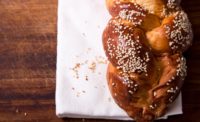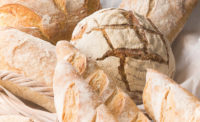Artisan breads rely on few ingredients—essentially flour, water, salt and yeast—each serving a critical function in the creation of a finished loaf. To produce consistent-quality breads, the baker needs to understand the role of each of these fundamental ingredients, how to select quality, how to use them in the proper way, and in the correct ratios.
Of the four, salt is perhaps the least complicated. The other basic ingredients have loads of variables to consider: the myriad types of flour with varying protein content and extraction rates, varying ratios of overall yeast and prefermented flour, the temperature of water. These factors, and the ways they may vary from bread to bread, season to season, or even bake day to bake day, need to be monitored and adjusted for on a daily basis. Salt is much more straightforward, although no less critical in producing the finished product.
The proper ratio of salt to flour in artisan bread is 1.8 percent to 2.0 percent of flour weight. Although this is a relatively small percentage of the overall dough, it plays a crucial role in helping make high-quality bread. The primary impact is flavor: Salt makes bread flavorful—as it does all food—and without salt, bread is bland. It is true that there are salt-free breads for consumers with specific dietary restrictions that require they stringently control their sodium intake. However, the amount of salt in most bread is quite modest, especially compared to other foods in the diet of many Americans.
Beyond flavor, salt also helps control the rate of fermentation by giving the baker some control over the enzyme and yeast activity. The salt acts like reins for the baker, slowing the rate of enzymatic conversion and fermentation. Bread dough without salt tends to overferment quickly.
Salt also increases the strength of the ionic bonds between the gluten strands. Without this added strength, dough is loose and rips very easily, especially during the shaping step. This characteristic can be easily observed by temporarily holding back the salt at the mixer: a handful of dough will shaggily break away from the dough mass during mixing. But as soon as the salt is added and thoroughly incorporated, the dough’s surface smooths out and dough strength develops.
At the mixing stage, one easy mistake a baker can make is to forget to add the salt. Without salt, the dough still does come together (although not quite in the same way), and an inexperienced mixer may miss the subtle visual cues mentioned above that arise with unsalted dough. A systematic mixing protocol should prevent the baker from forgetting this important step, and simply tasting the dough at the mixer is an easy confirmation. The blandness of unsalted dough is striking, and is even detectable by the dough’s aroma, or lack thereof.
Another important function of salt in bread is to extend shelf life. Properly salted bread has a longer shelf life than unsalted bread does, because salt retards microbial growth and is hygroscopic, so the bread does not dry out as quickly.
The functions of salt in a bread dough are the most simple to explain of the four fundamental ingredients, but that simplicity in no way diminishes importance of salt in the creation of fine bread. Without salt, bread dough would be weak, and the resulting baked loaves would have an insipid taste, an uninspiring crust, and would go stale more quickly.




